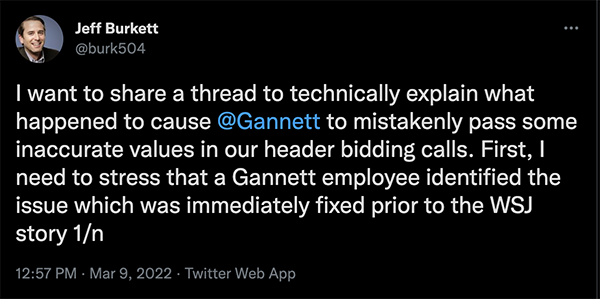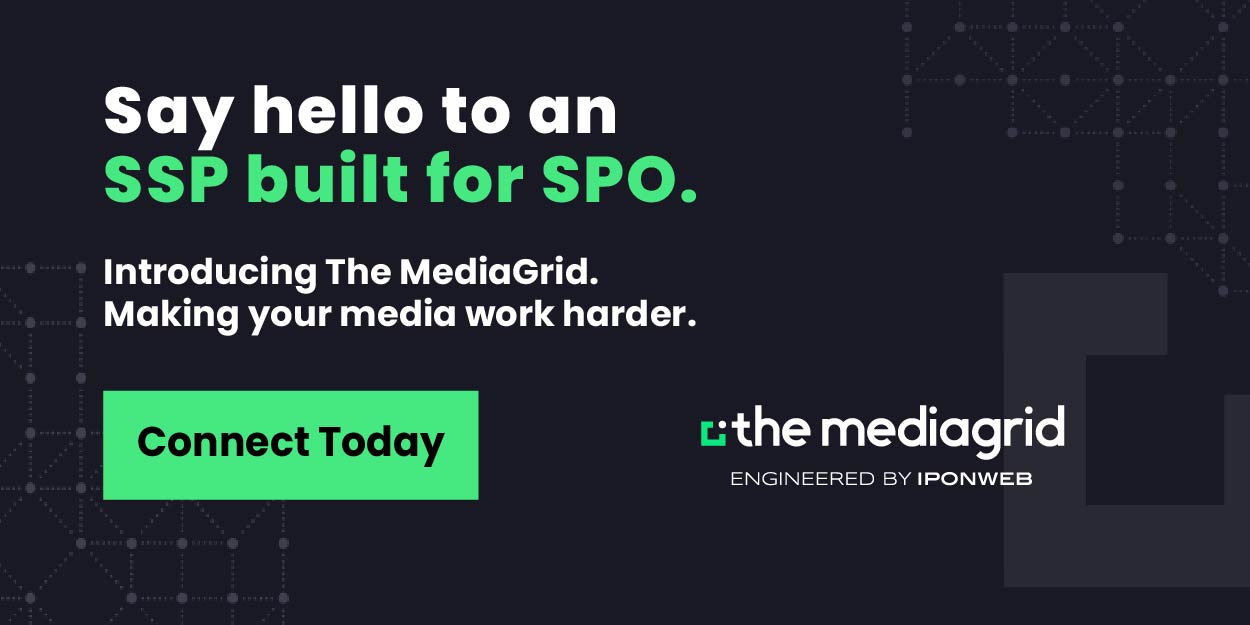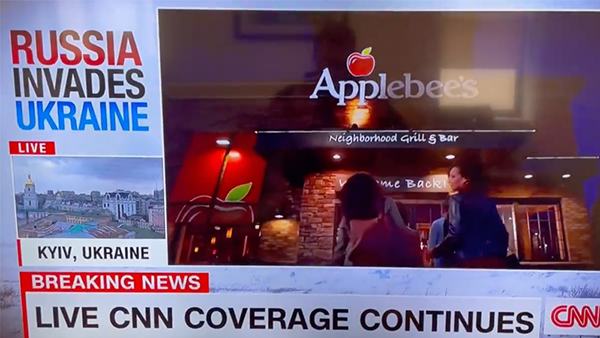 |
|||||||||||||||
|
|||||||||||||||
| Could What Happened to Gannett Happen to You? |
 |
| If you were at AdMonsters PubForum last week like we were, someone may have passed on the link to the WSJ story that announced: "USA Today owner Gannett Co. gave advertisers inaccurate information for nine months — Publisher misrepresented where billions of ads were placed, researchers say, and Gannett corrected the issue in recent days." The WSJ story was based on a report from independent ad industry researcher Braedon Vickers, who called Gannett out for domain spoofing. And like us, you probably jumped to all kinds of conclusions, initially thinking, "Wow, this is some FB-level ish!" Remember when Facebook was charged with misrepresenting ad reach to advertisers for years based on its faulty "potential reach metric?" Or even when after Apple iOS privacy updates, FB blamed those updates for miscalculating ad effectiveness for months? As we often do, we turned to ad tech Twitter for deeper analysis and debate, where we learned that perhaps this is something that could've happened to any publisher. Stephanie Layser, VP, Data, Identity & Ad Tech, immediately pointed out, nearly as soon as the story broke: "I just want to throw out that the Gannett issue is HIGHLY LIKELY an error and nothing nefarious on the part of the publisher. So please remember this when talking about it (and check your sites)." Gannett says the issue was the result of human error and was eventually rectified, and assures that procedures are being implemented to ensure that this type of error doesn't happen again. But this news highlights much larger industry issues: 1. Why didn't fraud detection companies catch the spoofing? 2. What didn't Gannett's ads.txt file catch the problem? |
| If you care to dig deep into the weeds, Jeff Burkett, VP, Product-Display Advertising, USA TODAY NETWORK, provides a technical thread on Twitter that explains how an upgrade of their ad tech to support the ORTB2.5 resulted in page level values being cached that shouldn't have been. Ad tech Twitter seems to agree that Gannett did not have any malicious intent in this matter, but there's still an elephant of a question remaining: Why didn't ad verification companies catch this issue for Gannett or its advertisers? IAB Tech Lab's Alex Cone doesn't think verification vendors are incentivized (as in they're working for the buy-side) to alert pubs to such issues. And this shines a light on how billions of ads can be misdirected without one single alarm going off and just how easy it is for ad fraud to run rampant all across the ecosystem. As Bob Hoffman (aka The Ad Contrarian) sums up as a general rule for everyone on every side of this equation: If you believe what anybody is selling you, you're a fool. And we'll loosely interpret this to mean: There should be a lot more checks and balances in place in the advertising ecosystem. As Krzysztof Franaszek pointed out in his Adalytics blog post, with further research on the Gannett issue: "1. DSPs, SSPs, and IVT vendors should monitor their internal data more closely to identify potential anomalies 2. Media buyers, agencies, and brands need to do log file reconciliation and audit" And of course, publishers should be triple-checking their own stuff. Never just set it and forget it. |
 |
| Supply Chain Short Cuts | ||
| In February, The Trade Desk announced the launch of OpenPath: a new tool that connects advertisers directly to premium publishers. Hot on the heels of this announcement, both Pubmatic and Magnite announced that they had struck major SPO deals with GroupM. There’s a running theme connecting all three of these announcements: buyers are starting to view supply access as a source of competitive advantage and differentiation. |
||
| Deals like these highlight a general trend in programmatic focused on closing the gap between advertisers and publishers — but getting closer to demand is just the first step. Smart publishers are seizing this opportunity to innovate new commercial arrangements with their buy-side partners, swapping 1st-look inventory access, post-auction discounts, data sharing agreements, measurement support, and reporting intelligence in exchange for larger spend commitments. Activating these types of arrangements, though, without disrupting entrenched buyer workflows and processes, requires purpose-built technology. The MediaGrid is a next-generation SSP and curation platform, designed with the sole purpose of bringing buyers and sellers closer together and empowering both sides with robust supply and data packaging tools that take SPO to a new level. Agencies are using The MediaGrid to curate bespoke supply marketplaces and data partnerships, while publishers are leveraging its data monetization and supply packaging tools to build new ad products that connect directly with agency buyers. Connect with The MediaGrid today to learn more. |
||
|
||
| Publishers Getting Squeezed by the Ukraine Invasion |
 |
| There's nothing like a bad ad placement to severely shake a publisher's money tree. It won't only reroute the next steps taken by an impacted advertiser — even unassociated advertisers will run to take cover. That's what happened when Applebee’s dancing cowboy ad ran adjacent to CNN’s Ukraine war report. It immediately became the center of social media finger-pointing and snickering — forcing Applebee’s to pull their ads and scold CNN as other advertisers began to second guess their news placements too. But this is just the tip of the iceberg of publishers beginning to feel the ripple effect of revenue potentially washing away (again). As coverage of Russia’s invasion of Ukraine increases, viewership is skyrocketing — but ad dollars could be paused, shifted, or stripped altogether as a result. Publications like the Financial Times are already feeling the squeeze as select advertisers have either delayed campaigns or want guarantees that their ads will not appear near any mentions of war or its effects. |
| There’s no denying hard news has been leading the charge these last couple of years. However, credible news and misinformation have become interwoven for advertisers as they protect their brands at all costs (and, rightfully so). What started as a fear of being associated with Covid-19 misinformation turned toward steering away from negative news altogether after the murder of George Floyd and now there's the Russian invasion of Ukraine. These reactions have caused keyword blocklists to scroll longer than a CVS receipt (no offense, the offers are great), making it nearly impossible for publishers to catch a break. Stiff arming news content may not be the answer. Shouldn't it be more about finding the right brand message that supports quality journalism on trusted sites? According to a Reach Solutions study, “Respondents were twice as likely to associate advertisers on news sites with quality, trustworthiness, and reliability than they were advertisers on social media or UGC video sites.” While no one wants to be viewed as tone-deaf amidst the cancel culture we live in, we have to find a better common ground besides pausing ad spend, pulling ads, and/or putting up keyword bumpers indefinitely. It diminishes the potential reach of advertising campaigns and the shelf life of publishers. Brand safety is just as important to advertisers as it is to most credible news sites but in order to achieve a true solution, both stakeholders will have to collaborate to define safe content instead of generalizing. This proactive approach may allow advertisers and publishers to take advantage of audience traffic when it is at its highest...even when it might mean associating with not-so-friendly news. |
| Dynamically-Inserted Ads — Welcome to the Podcast Party |
 |
| Yesterday’s podcasts are not today’s podcasts. Live host-read ads are now sharing the floor and may even be boxed out by dynamically-inserted ads, as they accounted for the majority of podcast ads served in 2020. Dynamically-inserted ads are providing great benefits to advertisers and large media networks as they automate the process, expand targeting and extend the reach and versatility of one creative spot for a fraction of the price. But the popularity of this server-side technology does not come without caveats. There’s a real concern around diluting the podcast experience with a more programmatic buying process that increases ad time in what’s known as a light ad environment. The biggest concerns are around lowering CPMs, higher ad loads, and even poor quality ads as pre-production processes vary by network and publisher. |
| The classic live read has been the heart of podcast advertising and it is widely accepted across the ecosystem. It serves as a seamless transition within content, delivered as a word-of-mouth recommendation from a trusted source — usually your favorite podcast host. The effectiveness is unmatched when coupled with timeliness. The reality, however, is we have all listened to an older podcast episode that featured a dated live-read ad. Some content can stand the test of time, but that's like finding a needle in a haystack. No wonder large media networks like iHeart committed to a fully dynamic ad-insertion model which contributed to a 148% increase in their podcast revenue in 2021, totaling $252.6 million. As you can see, a shift to dynamically-inserted ads can potentially blow off the revenue doors for networks and publishers of all sizes. However, it is important to note that iHeart’s model includes only pre-recorded ads read by hosts — marrying traditional and modern. According to a Nielsen study, the average brand recall for host-read podcast ads is 71%, compared to 62% for non-host-reads. Only time will truly tell, but from our viewpoint, DAI is the way to go for publishers who want to make some real money from podcasts. And while lower CPMs are a real possibility, DAI tech can also significantly increase impression delivery, likely resulting in more overall revenue. |
 |
||||||||
|
||||||||
 |
||||||||
|
||||||||
 |
||||||||
|







